Second Newsstand Period
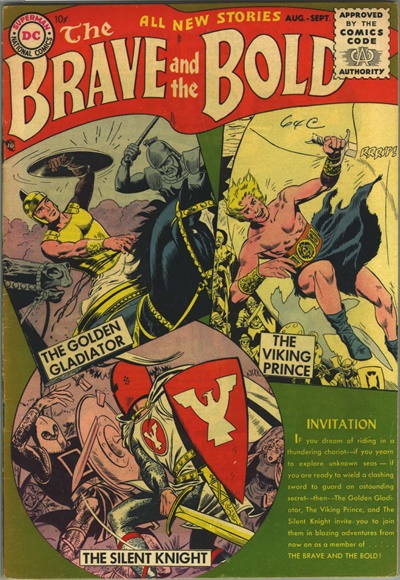 In August of 1955, DC published Brave and the Bold #1. The debuting issue had three sword fighting heroes. The 3 reoccurring
features were The Golden Gladiator written by France Herron with artist Russ Heath, Viking Prince by editor/writer Robert
Kanigher and artist by Joe Kubert and The Silent Knight also by Robert Kanigher with artist Irv Novick. The majority of the
early covers feature Silent Knight but Viking Prince and a newer feature Robin Hood would also appear. With
issue #25 The Suicide Squad would debut.
It was about a team of military personal who were each the sole survivors of an event. They used their knowledge and
skills to take on threats out of science fiction that the regular military couldn't handle. It was also done by Robert
Kanigher but with artists Ross Andru & Mike Esposito. While the group would later on reappear in the title the name Suicide
Squad would be given to a superhero group - or rather, Supervillains now doing dangerous, dirty government work in order to
get a pardon. Brave and the Bold would debut some more characters and teams, then would become a team up book for two popular
superheroes and or groups, which we'll get to. With issue #74 on, it turned into a Batman and another hero team up book. Over
all this title would go until 1983 ending with issue #200. The last story featured Batman and the Outsiders, which started
their own title the very next month.
In August of 1955, DC published Brave and the Bold #1. The debuting issue had three sword fighting heroes. The 3 reoccurring
features were The Golden Gladiator written by France Herron with artist Russ Heath, Viking Prince by editor/writer Robert
Kanigher and artist by Joe Kubert and The Silent Knight also by Robert Kanigher with artist Irv Novick. The majority of the
early covers feature Silent Knight but Viking Prince and a newer feature Robin Hood would also appear. With
issue #25 The Suicide Squad would debut.
It was about a team of military personal who were each the sole survivors of an event. They used their knowledge and
skills to take on threats out of science fiction that the regular military couldn't handle. It was also done by Robert
Kanigher but with artists Ross Andru & Mike Esposito. While the group would later on reappear in the title the name Suicide
Squad would be given to a superhero group - or rather, Supervillains now doing dangerous, dirty government work in order to
get a pardon. Brave and the Bold would debut some more characters and teams, then would become a team up book for two popular
superheroes and or groups, which we'll get to. With issue #74 on, it turned into a Batman and another hero team up book. Over
all this title would go until 1983 ending with issue #200. The last story featured Batman and the Outsiders, which started
their own title the very next month.
 DC was still doing well with their romance books, well enough to add a new title. Falling In Love #1 had a September 1955 cover
date and the book went 143 issues ending in October of 1973. What made this title different from other DC romance books is that
had no continuing stories or characters during it's run. There is not a lot known about the book other than Irv Novick and
Arthur Peddy did some of the artwork inside. There were multiple 7 to 8 page stories. Like most DC Romance books these stories
were about a young lady trying to find Mr. Right to marry.
DC was still doing well with their romance books, well enough to add a new title. Falling In Love #1 had a September 1955 cover
date and the book went 143 issues ending in October of 1973. What made this title different from other DC romance books is that
had no continuing stories or characters during it's run. There is not a lot known about the book other than Irv Novick and
Arthur Peddy did some of the artwork inside. There were multiple 7 to 8 page stories. Like most DC Romance books these stories
were about a young lady trying to find Mr. Right to marry.
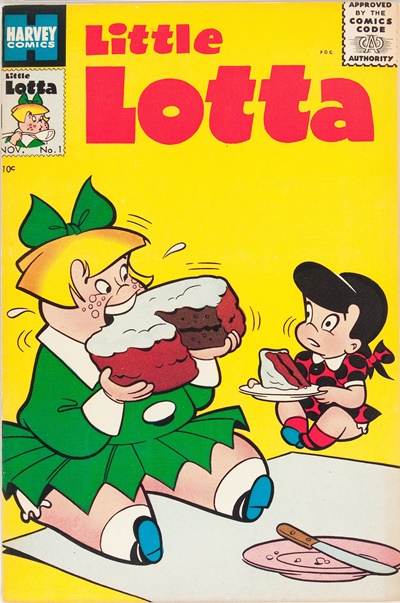 Harvey Comics expanded their kids comics line by giving series to 3 of their characters. Little Lotta got own her series in
September 1955. She first appeared in Little Dot #1. The character was a girl who ate a ginormous amounts of food but it gave
her super strength.
Spooky the Tuff Little Ghost (September 1955)
also made his debut this month. He was similar to Casper except he was sometimes
bad and scared people by yelling BOO! Baby Huey (July 1956),
was a giant clumsy Duck that was much bigger than his parents. He first appeared in 1949's Casper the Friendly Ghost #1 put out
by St. Johns Publishing. The character was designed for cartoons, but he appeared in the comic books before the cartoon aired.
After Harvey bought St. Johns rights to those characters they mined them for more titles.
Harvey Comics expanded their kids comics line by giving series to 3 of their characters. Little Lotta got own her series in
September 1955. She first appeared in Little Dot #1. The character was a girl who ate a ginormous amounts of food but it gave
her super strength.
Spooky the Tuff Little Ghost (September 1955)
also made his debut this month. He was similar to Casper except he was sometimes
bad and scared people by yelling BOO! Baby Huey (July 1956),
was a giant clumsy Duck that was much bigger than his parents. He first appeared in 1949's Casper the Friendly Ghost #1 put out
by St. Johns Publishing. The character was designed for cartoons, but he appeared in the comic books before the cartoon aired.
After Harvey bought St. Johns rights to those characters they mined them for more titles.
All three of these titles would do very well for Harvey Comics. Lotta would also have a spinoff called
Little Lotta Foodland (1963)
that went 29 issues. Spookys series went 161 issues, but from issue #139 (1973) to the end the title would
go through several stops and starts with many months in between. Like the other characters Spooky got a spinoff series called
Spooky Spooktown (1961) and it went 66 issues.
Baby Huey would go 101 issues, ending in 1990. It should be said that issue #97 was published in 1971. Issue #98 was published
in 1972, #99 in 1980, #100-1 in 1990. There were two other short lived Baby Huey spin off books in the 60s. Little Lotta would
go 120 issues, stopping in 1976. It should be said there was a 10 month wait between issue #110 and #111. Harvey would have more
success in the near future.
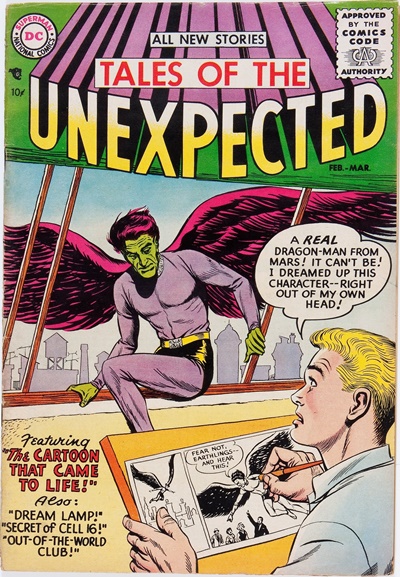 The only new long lasting titles to pop up during this time would be DC's weird / sci-fi stories. They were very watered down
horror books with a lot of sci-fi in them. Among them would be Tales of the Unexpected (December 1955) which would be the
longest lasting series to not convert into a superhero book. It would end in 1982 going #222 issues. With issue #105 the title
would shorten to The Unexpected.
The only new long lasting titles to pop up during this time would be DC's weird / sci-fi stories. They were very watered down
horror books with a lot of sci-fi in them. Among them would be Tales of the Unexpected (December 1955) which would be the
longest lasting series to not convert into a superhero book. It would end in 1982 going #222 issues. With issue #105 the title
would shorten to The Unexpected.
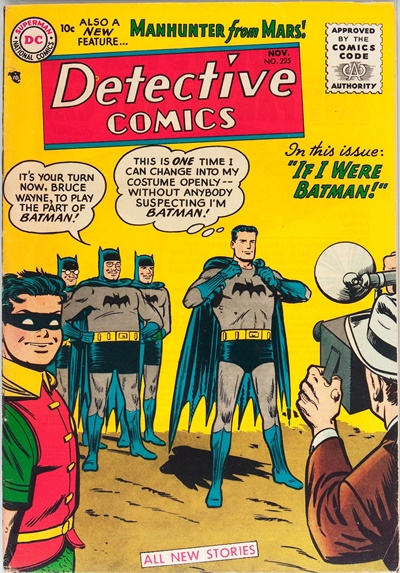 In September of 1965 Detective Comics was published and after the Batman story there was a back up feature about a new
character named Martian Manhunter. He was an alien from Mars who had the ability to alter his appearance, read peoples thoughts,
fly, turn invisible, super strength and other powers. He would change his appearance to be a human and became a detective
under the name John Jones, which was similar to his Martian name of J'onn J'onzz. The story was by writer Joseph Samachson
and drawn by Joe Certa. The character would become a regular superhero within DC comics. It would be a long time before he
got his own series (miniseries in 1988, 1992, ongoing in 1998), but he would be a mainstay in The Justice League of America,
a popular superhero team.
In September of 1965 Detective Comics was published and after the Batman story there was a back up feature about a new
character named Martian Manhunter. He was an alien from Mars who had the ability to alter his appearance, read peoples thoughts,
fly, turn invisible, super strength and other powers. He would change his appearance to be a human and became a detective
under the name John Jones, which was similar to his Martian name of J'onn J'onzz. The story was by writer Joseph Samachson
and drawn by Joe Certa. The character would become a regular superhero within DC comics. It would be a long time before he
got his own series (miniseries in 1988, 1992, ongoing in 1998), but he would be a mainstay in The Justice League of America,
a popular superhero team.
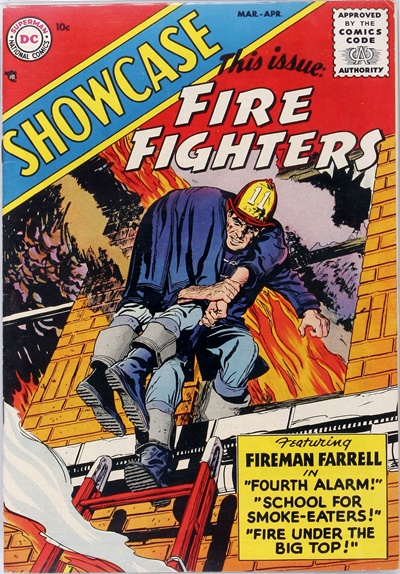 Showcase Comics was unique in that it was designed to showcase new genres, as nothing was really selling. According to DC
Comics, they got a letter from a fan named Larry Blake who suggested a title devoted to Fire Fighters. They used that
suggestion in the first issue of Showcase and was originally advertised the titles as feature ideas that come from fans like
Larry. But only at first, it didn't suggest that fans write in any more suggestions. The title was unique in how it was run
as DC editors took turns creating ideas for the title in regularly held meetings. The first issue with Fire Fighters was
edited by Mort Weisinger and it sold very badly. Weisinger was the editor of the Superman line and after this book he didn't
edit anything outside of Superman mythos ever again.
Showcase Comics was unique in that it was designed to showcase new genres, as nothing was really selling. According to DC
Comics, they got a letter from a fan named Larry Blake who suggested a title devoted to Fire Fighters. They used that
suggestion in the first issue of Showcase and was originally advertised the titles as feature ideas that come from fans like
Larry. But only at first, it didn't suggest that fans write in any more suggestions. The title was unique in how it was run
as DC editors took turns creating ideas for the title in regularly held meetings. The first issue with Fire Fighters was
edited by Mort Weisinger and it sold very badly. Weisinger was the editor of the Superman line and after this book he didn't
edit anything outside of Superman mythos ever again.
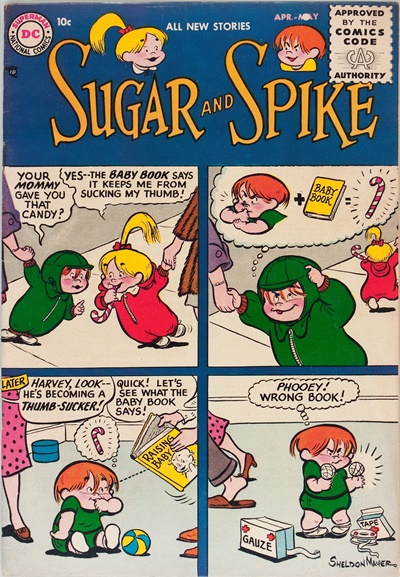 Sugar and Spike #1 came out February of 1956. This was created by writer/artist and former DC editor Sheldon Mayer. The series
had two babbling babies that could understand each other but the adults around them couldn't comprehend. The two were
neighbours but played together, often getting into mischief. Sometimes they imitate adults and would end up sitting in a
corner for punishment. The babies were originally based on Sheldon's own kids. They were teenagers when he started the strip
but Sheldon had made home movies of them when they were younger. Eventually Sheldon starting watching the kids in his
neighbourhood, kids his daughter would babysit and eventually his grandkids for inspiration. The stories were very short at
first but eventually got longer. It was aimed at young kids and had a long run, going 98 issues and ending in 1971. It stopped
in part because Sheldon had cataracts in his eyes and he needed an eye operation. This series came about because DC asked
Sheldon to come up with something similar to Dennis the Menace, which was very popular at that time. Sheldon refused to be a
copycat in that way, but as Hank Ketcham used his kids for inspiration Sheldon used his own for his to come up with a
different idea. Many people in the comics industry noticed the popular cartoon Rugrats had many similarities to Sugar and
Spike.
Sugar and Spike #1 came out February of 1956. This was created by writer/artist and former DC editor Sheldon Mayer. The series
had two babbling babies that could understand each other but the adults around them couldn't comprehend. The two were
neighbours but played together, often getting into mischief. Sometimes they imitate adults and would end up sitting in a
corner for punishment. The babies were originally based on Sheldon's own kids. They were teenagers when he started the strip
but Sheldon had made home movies of them when they were younger. Eventually Sheldon starting watching the kids in his
neighbourhood, kids his daughter would babysit and eventually his grandkids for inspiration. The stories were very short at
first but eventually got longer. It was aimed at young kids and had a long run, going 98 issues and ending in 1971. It stopped
in part because Sheldon had cataracts in his eyes and he needed an eye operation. This series came about because DC asked
Sheldon to come up with something similar to Dennis the Menace, which was very popular at that time. Sheldon refused to be a
copycat in that way, but as Hank Ketcham used his kids for inspiration Sheldon used his own for his to come up with a
different idea. Many people in the comics industry noticed the popular cartoon Rugrats had many similarities to Sugar and
Spike.
Sheldon also started The Three Mouseketeers, which came out a month before Sugar and Spike but it didn't last as long.
Sugar and Spike was more popular so DC wanted Sheldon to focus his attention on that title. Rube Grossman took over the
Mouseketeer's title with issue #8. The series ended in October of 1960 with issue #26. Sheldon was not happy that the
Mouseketeers series died and decided he didn't want anybody else handling Sugar and Spike. DC respected his wishes, even to the
point of turning down a Sugar and Spike cartoon. After the operation Sheldon would continue to create new Sugar and Spike
comics but they were for the overseas market. A few of those stories would see print in America in digest sized comics along
with other kids comics. Sheldon did Sugar and Spike until his death in 1992.
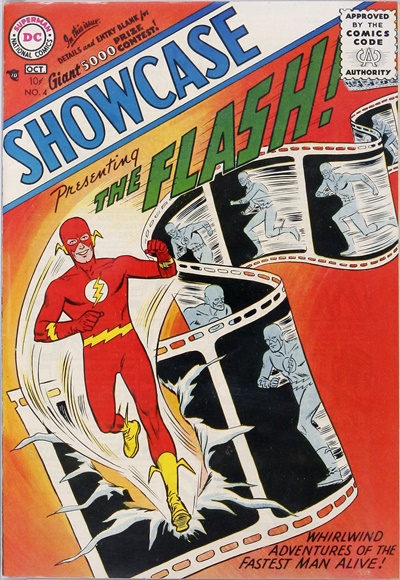 Showcase Comics struck pay dirt with issue #4 (July, 1956). It featured the return of the superhero called the Flash. At one
of the editor meetings somebody came up with the idea of bringing back the Flash. Nobody is sure who came up with it, but
because Julie Schwartz was the editor of the Flash during his previous run, everybody looked to him to bring the character
back. Julie agreed, figuring it had been more than 5 years since the Flash was around and it was generally accepted that the
entire comic reading audience replenished itself with all new readers every 5 years. But Julie did want a free hand to make
some sweeping changes. He didn't want the same character.
Showcase Comics struck pay dirt with issue #4 (July, 1956). It featured the return of the superhero called the Flash. At one
of the editor meetings somebody came up with the idea of bringing back the Flash. Nobody is sure who came up with it, but
because Julie Schwartz was the editor of the Flash during his previous run, everybody looked to him to bring the character
back. Julie agreed, figuring it had been more than 5 years since the Flash was around and it was generally accepted that the
entire comic reading audience replenished itself with all new readers every 5 years. But Julie did want a free hand to make
some sweeping changes. He didn't want the same character.
Editors Julie and Robert Kanigher came back from that meeting and the deadline for the new book was tight. Since Robert
Kanigher was also a quick and talented writer, Julie got him to whip out the script to the first story. They likely came up
with some basic character elements, the origin of a lightning bolt crashing a collection of every chemical known to man onto
the hero, giving him powers was likely Julie's invention. Schwartz also named him Barry Allen after talk show hosts Barry Gray
and Steve Allen. Kanigher would write a detailed script, making Barry Allen a scientist that worked from the police crime lab,
made him somebody that's always late for everything. He also had a girlfriend named Iris Allen that he needed to keep his
secret identity from. Kanigher would also come up with a cover concept for the issue. There was a 2nd Flash story in the issue
and it was written by John Broome.
The script would go to artist Carmine Infantino to draw. Carmine was told to forget the old Flash and create an original
look for both him and his costume. Carmine was a fast artist, did a great job showing speed and was a very talented designer.
He came up with the simple and iconic costume overnight and it was approved immediately. Carmine would also go on to design
many of Flash's famous Rouge Gallery. The issue was inked by artist Joe Kubert, who was available and could get it done quick.
After the book was published they got sales figures. Julie would tell Carmine that he would be doing a lot more Flash in the
future. John Broome would write the new Flash stories. Frank Giacoia would take over as inker due to being a one of the better
inkers, somebody who worked on the original Flash previously and a boyhood friend of Infantino.
The Flash did well and after a few appearances in Showcase comics he received his own title. DC decided to start his title
with #105, because the Golden Age Flash title ended with 104 - and they wanted to title to sell to both newsstands and
fans who had more faith in established titles then brand new ones. The success of The Flash caused other golden-age heroes to
come back, although revamped like The Flash. In short, The Flash became a hero on two fronts, first in the comic book and
second in the comic industry. Bringing back The Flash brought superheroes back into popularity and changed the comic industry
to this day. Superhero comics are still a dominate genre in the comics market and have branched out to movies, cartoons, TV
shows.
Behind the Scenes - Robert Kanigher: Plagerist!
"The Flash's ring was sheer plagiarism. When I was a pre-teen or almost a teenager, I used to sit on the
steps of a tenement house at Washington Ave. and about 179th Street, with a rabbi's son, who was an
aspiring pulp writer. He told me about a character running in a pulp. Called the Crimson Clown, I
believe. When he wanted to switch from his civvies, he pressed a spring on a ring on his finger. The
clown costume erupted out and expanded to life-size. So, many years later, I stole that gimmick. You
can't sue me. The statute of limitations has run out."
From: "The Showcase Solution" by Robert Kanigher. The Comics, Vol. 9, #4, April 1998.
DC would do a variety of superheroes during this period. Some of them were brand new, some were Golden Age heroes modernized.
Many would get their own titles; some would simply be the headline feature in another book. Among them:
The Space Ranger - Showcase #15 (May 1958) headlined Tales of the Unexpected starting in issue #40
Adam Strange - Showcase #17 (September 1958) lead feature in Mystery in Space with issue #53 (1959)
Rip Hunter, Time Master - Showcase #20 (March 1959) - Got his own series in March 1961.
Hawkman and Hawkwoman - Brave and the Bold #34 (December 1960) - Got his own series in 1964.
Atom - Showcase #34 (July 1961) - Got his own series in 1962.
Metal Men - Showcase #37 (January 1962) - Got their own series in April 1963.
Doom Patrol - My Greatest Adventure #80 (April 1963) - Took over the title, renamed The Doom Patrol with issue #86 (1964)
Teen Titans - Brave and the Bold #54 (April 1964) - Got their own series in 1966.
Metamorpho - Brave and the Bold #57 (October 1964) - Got his own series in 1965
Dr. Fate and Hourman - Showcase #55 (January 1965) - Both became regular characters in DC and eventually get thier own series.
Black Canary - Brave and the Bold #61 (June 1965) - Regular character and eventual series.
Spectre - Showcase #60 (November 1965) - Got his own series in 1967.
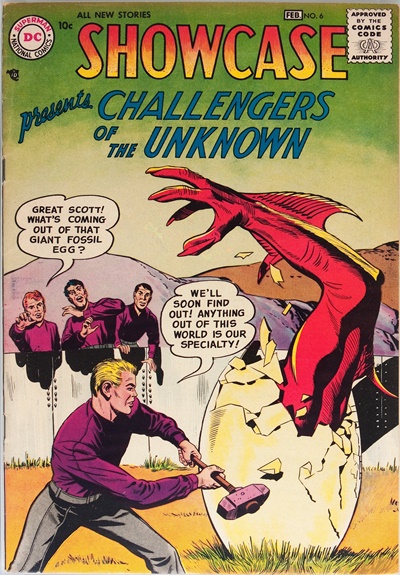 In the November of 1956 Showcase #6 debuted Challengers of the Unknown by Jack Kirby. This series has 4 characters who
recently lived through a near death experience. They were Ace Morgan - test pilot, Red Ryan - mountain climbing daredevil,
Rocky Davis - heavyweight boxing champion & Olympic wrestler and Prof Haley - deep sea scientist. Each used their area of
expertise to risk their necks in doing good deeds. They figured they were all living on borrowed time anyhow, so they didn't
really care if they lived or died. The first issue appears to be left over work from the Simon and Kirby Company/Studio
Mainline Comics. Jack proposed the book to DC and they agreed to put it in an issue of Showcase Comics. Jack Kirby continued
to do new stories after that. The plot/script would be a mix of Dave Wood and Kirby working together. This would be the first
work Kirby he had done without Joe Simon in over 15 years. Challengers of the Unknown would get their own title in April of
1958 and within it Kirby would make another innovation to comic books. He would use the entire comic to tell one story. Prior
to this virtually all comics had a series of short stories. The only odd exception would be the old JSA stories in All Star
Comics, but even those stories broke up the characters into teams and they had their own mini stories with the big story.
In the November of 1956 Showcase #6 debuted Challengers of the Unknown by Jack Kirby. This series has 4 characters who
recently lived through a near death experience. They were Ace Morgan - test pilot, Red Ryan - mountain climbing daredevil,
Rocky Davis - heavyweight boxing champion & Olympic wrestler and Prof Haley - deep sea scientist. Each used their area of
expertise to risk their necks in doing good deeds. They figured they were all living on borrowed time anyhow, so they didn't
really care if they lived or died. The first issue appears to be left over work from the Simon and Kirby Company/Studio
Mainline Comics. Jack proposed the book to DC and they agreed to put it in an issue of Showcase Comics. Jack Kirby continued
to do new stories after that. The plot/script would be a mix of Dave Wood and Kirby working together. This would be the first
work Kirby he had done without Joe Simon in over 15 years. Challengers of the Unknown would get their own title in April of
1958 and within it Kirby would make another innovation to comic books. He would use the entire comic to tell one story. Prior
to this virtually all comics had a series of short stories. The only odd exception would be the old JSA stories in All Star
Comics, but even those stories broke up the characters into teams and they had their own mini stories with the big story.
Challengers of the Unknown #4 and #5 were full 25 page stories. With issue #6 the editor switches from Jack Schiff to
Whitney Ellsworth and the format goes back two smaller stories. With issue #8 Schiff is back and with #9 another artist takes
over the series. A lot of this likely had to do with a dispute outside of DC Comics. Jack Kirby was doing a syndicated comic
strip called Sky Masters, with other creators helping him with the dialogue, inking and lettering. Jack Kirby and the Wood
brothers got into a dispute with splitting the money from the strip. They originally wanted a 4%-10% to Jack Schiff for
suggesting the creators for the strip and the rest would be a 50/50 split between Kirby and the Wood brothers. Kirby objected
to the 50/50 split because he was having to pay an inker & letters out of his half. He also objected to Schiff's percentage
believing a flat amount would more reasonable as Schiff had nothing to do with producing the strip on an ongoing basis. They
did agree to change the 50/50 split to 60/40, but Schiff was insistent on his percentage. He suggested Kirby's would no longer
have work at DC unless he signed the agreement. Kirby signed the contract under duress and felt it was illegal. When Schiff
didn't get any money from Kirby he sued Kirby, which lead to Kirby suing Schiff back. The judge sided with Schiff and Kirby
had to pay him 4% of all the money that came from the strip plus all his legal fees. The strip was cancelled in 1961 and Kirby
would devote himself to comic books, swearing to never work for a comic strip syndicate again. DC had blacklisted Kirby and he
went to work for Marvel. Jack Schiff retired in 1967. New editor Carmine Infantino hired Jack Kirby in 1970 and said he
received all sorts of flack within DC for hiring Kirby at that time, but did it anyway.
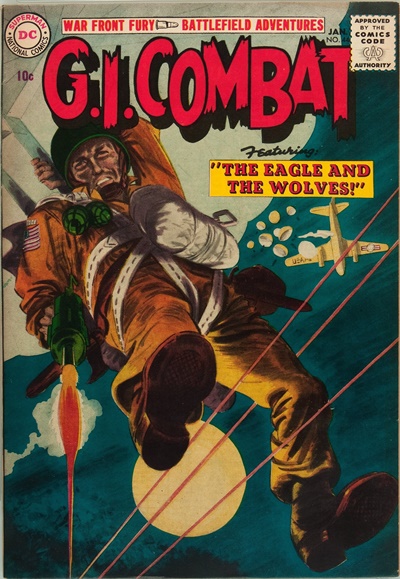 When Everet "Busy" Arnold shut down Quality Comics he made a deal to sell his titles and characters to DC Comics. DC continued
to publish 4 of their titles taking over Blackhawk, G.I. Combat, Heart Throbs and Robin Hood Tales. In November of 1956 they
took over 3 of those titles. The first issues by DC was GI Combat #44, Blackhawk #108,
Robin Hood Tales #7. In February of 1957 they took over
Heart Throbs with issue #47. G.I. Combat was the
longest running of these titles as it went #288 issues, ending in 1987. Heart Throbs would continue until issue #146, ending
in 1972. Blackhawk would be the best selling title and go #273 issues, ending in 1984. Blackhawk has since been brought back for miniseries
and ongoing series, but none of them lasting that long. Robin Hood Tales ended quickly, ending in March of 1958 with issue #14.
Also significant about this deal would be the other Quality characters DC bought in the process. Plastic Man was now owned by
DC Comics, but it wasn't until House of Mystery #160 (1966)
in a Dial H for Hero story did they make use of the name. The character was given his own title in 1966, but it would only go 10 issues.
Plastic Man would occasionally be given new series and appear in other titles. Other characters like Black Condor, Doll Man,
Manhunter and many others would eventually make appearances in DC superhero titles.
When Everet "Busy" Arnold shut down Quality Comics he made a deal to sell his titles and characters to DC Comics. DC continued
to publish 4 of their titles taking over Blackhawk, G.I. Combat, Heart Throbs and Robin Hood Tales. In November of 1956 they
took over 3 of those titles. The first issues by DC was GI Combat #44, Blackhawk #108,
Robin Hood Tales #7. In February of 1957 they took over
Heart Throbs with issue #47. G.I. Combat was the
longest running of these titles as it went #288 issues, ending in 1987. Heart Throbs would continue until issue #146, ending
in 1972. Blackhawk would be the best selling title and go #273 issues, ending in 1984. Blackhawk has since been brought back for miniseries
and ongoing series, but none of them lasting that long. Robin Hood Tales ended quickly, ending in March of 1958 with issue #14.
Also significant about this deal would be the other Quality characters DC bought in the process. Plastic Man was now owned by
DC Comics, but it wasn't until House of Mystery #160 (1966)
in a Dial H for Hero story did they make use of the name. The character was given his own title in 1966, but it would only go 10 issues.
Plastic Man would occasionally be given new series and appear in other titles. Other characters like Black Condor, Doll Man,
Manhunter and many others would eventually make appearances in DC superhero titles.
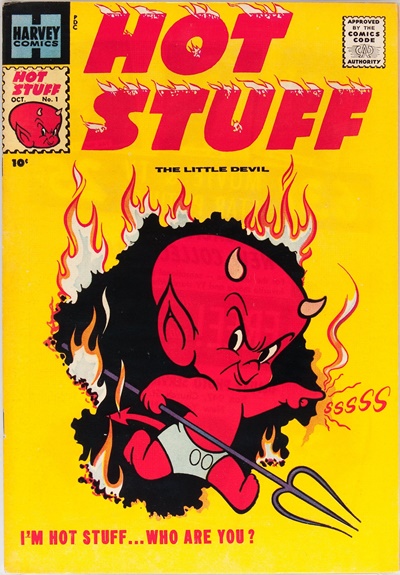 Hot Stuff made his debut in Hot Stuff, the Little Devil #1 in August 1957. His own title did very well, going 173 issues and
ending in 1990, but towards the end there were long multi-month hiatuses between issues. Hot Stuff would also star in several
spin off issues including Devil Kids, staring Hot
Stuff (107 issues, 1962 - 1981), Hot Stuff Sizzlers (59 issues, 1960 - 1974)
and Hot Stuff Creepy Caves (7 issues, 1974 - 1975). The character was created by Warren Kremer. His stories were also often
drawn by Howard Post and Ernie Colon. He was a little devil boy that wore asbestos diapers and had a trident that would
occasionally have a mind of its own. Hot Stuff would do a mix of bad and good deeds with his fire powers and unlike other
Harvey characters, he rarely crossed over with other characters. When he did, it was usually with Casper the Friendly Ghost.
Hot Stuff made his debut in Hot Stuff, the Little Devil #1 in August 1957. His own title did very well, going 173 issues and
ending in 1990, but towards the end there were long multi-month hiatuses between issues. Hot Stuff would also star in several
spin off issues including Devil Kids, staring Hot
Stuff (107 issues, 1962 - 1981), Hot Stuff Sizzlers (59 issues, 1960 - 1974)
and Hot Stuff Creepy Caves (7 issues, 1974 - 1975). The character was created by Warren Kremer. His stories were also often
drawn by Howard Post and Ernie Colon. He was a little devil boy that wore asbestos diapers and had a trident that would
occasionally have a mind of its own. Hot Stuff would do a mix of bad and good deeds with his fire powers and unlike other
Harvey characters, he rarely crossed over with other characters. When he did, it was usually with Casper the Friendly Ghost.
 Artist Alex Toth is among the cornerstones of comic book artists. He taught many artists how to draw comics with an innovative
flair. He was the personification of the "less is more" school of thought and explored and invented many new storytelling
techniques. Toth's work is quite varied as he didn't stay on any one project very long. One of the longest and better
remembered works is his run on the Zorro series, which began with his work in Four Color Comics #882 (December 1957). He
continued to work on it for about 4 years. He would leave the comic industry and work for Hanna-Barbera as a character
designer, among his better known works there is Space Ghost.
Artist Alex Toth is among the cornerstones of comic book artists. He taught many artists how to draw comics with an innovative
flair. He was the personification of the "less is more" school of thought and explored and invented many new storytelling
techniques. Toth's work is quite varied as he didn't stay on any one project very long. One of the longest and better
remembered works is his run on the Zorro series, which began with his work in Four Color Comics #882 (December 1957). He
continued to work on it for about 4 years. He would leave the comic industry and work for Hanna-Barbera as a character
designer, among his better known works there is Space Ghost.
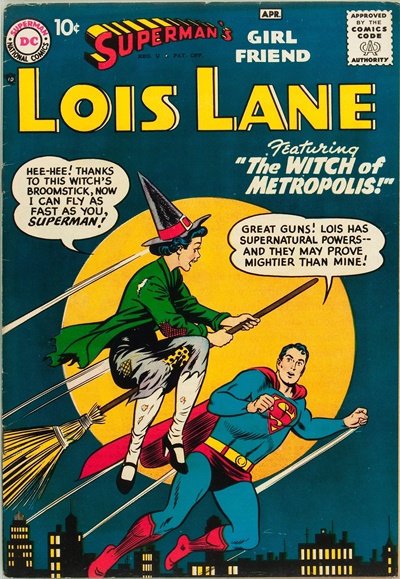 Superman was so popular in the 1950s that even his supporting characters got popular, long running titles.
Superman's Girlfriend Lois Lane got a tryout in issues of Showcase #9
and #10 (1957) and got her own series
in January 1958. The title went 137 issues ending in 1974. In 1959 Super Girl made her debut in
Action Comics #252.
She was Kara Zor-El, Superman's cousin from Argo City on Krypton. Argo City survived tact from the initial destruction of
Kyrpton but would soon fall to the poisoning of Krytonite radiation. She appears on Earth via rocket ship, not unlike Superman.
Except Kara was 15 at the time she made it to Earth. Superman originally put Kara into an orphanage, she was then given foster
parents. Superman gave her strict instructions to never reveal her true identity or powers. Super Girl would appear frequently
in Action and Adventure Comics and would join the Legion of Superheroes for a time. She would get her own series in 1972.
It went 10 issues, ending in 1974. DC would convert Superman's Pal Jimmy Olsen into The Superman Family with issue #164 (1974)
and have Jimmy's, Lois's and Super Girl's stories in one title. The Superman Family ended in 1982 with issue #222.
Superman was so popular in the 1950s that even his supporting characters got popular, long running titles.
Superman's Girlfriend Lois Lane got a tryout in issues of Showcase #9
and #10 (1957) and got her own series
in January 1958. The title went 137 issues ending in 1974. In 1959 Super Girl made her debut in
Action Comics #252.
She was Kara Zor-El, Superman's cousin from Argo City on Krypton. Argo City survived tact from the initial destruction of
Kyrpton but would soon fall to the poisoning of Krytonite radiation. She appears on Earth via rocket ship, not unlike Superman.
Except Kara was 15 at the time she made it to Earth. Superman originally put Kara into an orphanage, she was then given foster
parents. Superman gave her strict instructions to never reveal her true identity or powers. Super Girl would appear frequently
in Action and Adventure Comics and would join the Legion of Superheroes for a time. She would get her own series in 1972.
It went 10 issues, ending in 1974. DC would convert Superman's Pal Jimmy Olsen into The Superman Family with issue #164 (1974)
and have Jimmy's, Lois's and Super Girl's stories in one title. The Superman Family ended in 1982 with issue #222.
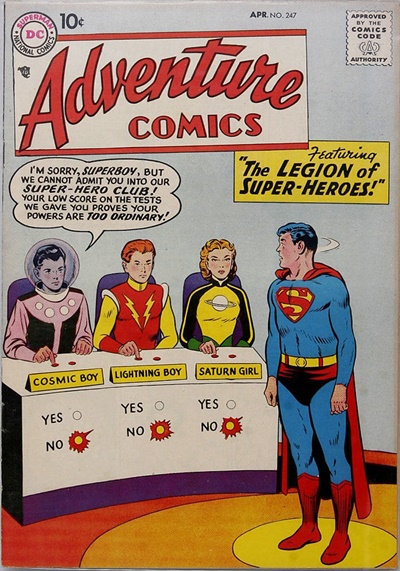 Adventure Comics #247 (February 1958) was the first appearance of The Legion of Superheroes. Published by DC Comics, they were
a group of children superheroes from the 30th century future. In this issue Superboy is taken to the future and does a variety
of tests to see if he can get into the exclusive group. By the end of the issue he is let in and slowly the Legion of
Superheroes would make more appearances in both Adventure and Action Comics. In Adventure Comics #300 (1962)
the Legion would become a regular, ongoing feature, co-staring with Superboy. Soon their stories wouldn't involve Superboy. With
Adventure Comics #381 (1969) the Legion were replaced
with Super Girl, but they would survive in back of Action Comics and Superboy. They would gain cover billing with
Superboy in issue #197. The
Legion would take over Superboys title with issue #259.
From there the Legion would remain a regular feature, but their series and history would often reboot with a new #1 and a
re-written history.
Adventure Comics #247 (February 1958) was the first appearance of The Legion of Superheroes. Published by DC Comics, they were
a group of children superheroes from the 30th century future. In this issue Superboy is taken to the future and does a variety
of tests to see if he can get into the exclusive group. By the end of the issue he is let in and slowly the Legion of
Superheroes would make more appearances in both Adventure and Action Comics. In Adventure Comics #300 (1962)
the Legion would become a regular, ongoing feature, co-staring with Superboy. Soon their stories wouldn't involve Superboy. With
Adventure Comics #381 (1969) the Legion were replaced
with Super Girl, but they would survive in back of Action Comics and Superboy. They would gain cover billing with
Superboy in issue #197. The
Legion would take over Superboys title with issue #259.
From there the Legion would remain a regular feature, but their series and history would often reboot with a new #1 and a
re-written history.
The Legion were created by writer Otto Binder, artist Al Plastino with editor Mort Weisinger. They had a wide variety of
creators working on it over the years, most notably Paul Levitz who would become Publisher and President of DC Comics. Jerry
Siegel would write some early stories and a 13 year old Jim Shooter would also write them. Shooter would eventually become
Editor in Chief of Marvel Comics. Along the way many writers and artists would create a slew of kid superhero characters for
the Legion. Today the Legion has over 50 heroes in their history, but usually only a small portion of them are used in their
stories. The Legion of Superheroes were never a best selling title, but it's known for their diehard fans that keep them
going in one form or another.
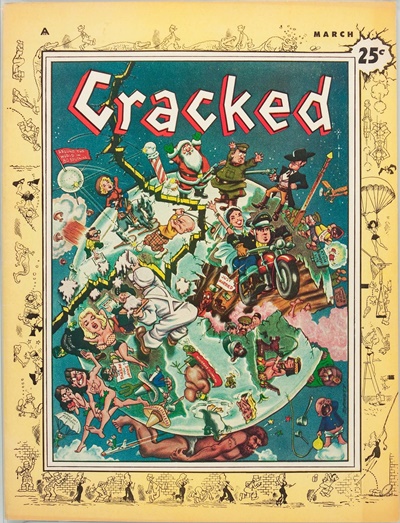 With the success of MAD Magazine there were a lot of publishers trying to compete by doing knock offs. Only one managed to
survive and that was Cracked. It was published by Robert C. Sproul's Major Magazines Inc., a company that did copycats of
many successful magazines. Cracked first editor was Sol Brodsky, who would soon go on to work for Marvel. The artist most
associated with Cracked is John Severin. He worked at EC and MAD magazine before going to Cracked. Throughout most of Cracked
history, they've been seen as a distant 2nd to MAD magazine. Their sales were lower than MAD, they paid artists less then MAD,
good artists working for Cracked would often end up working at MAD and MAD writers would often submit their rejected ideas to
Cracked for publication. It should be said it wasn't always this way. In 1987 Cracked made a "raid" on MADs top talent. Don
Martin had already left MAD due to a dispute and he signed up with Cracked. Offers were made to other popular artists as well
(Mort Drucker turned them down) and Lou Silverstone would become their editor and writer. Cracked had a revolving door of
people from both MAD and National Lampoon magazines and for a while they published Steve Ditko and Gene Colan work. To their
credit they did give work to some upcoming artists like Dan Clowes, Peter Bagge and Rick Altergott. All of whom would become
better known in the alternative comics market.
With the success of MAD Magazine there were a lot of publishers trying to compete by doing knock offs. Only one managed to
survive and that was Cracked. It was published by Robert C. Sproul's Major Magazines Inc., a company that did copycats of
many successful magazines. Cracked first editor was Sol Brodsky, who would soon go on to work for Marvel. The artist most
associated with Cracked is John Severin. He worked at EC and MAD magazine before going to Cracked. Throughout most of Cracked
history, they've been seen as a distant 2nd to MAD magazine. Their sales were lower than MAD, they paid artists less then MAD,
good artists working for Cracked would often end up working at MAD and MAD writers would often submit their rejected ideas to
Cracked for publication. It should be said it wasn't always this way. In 1987 Cracked made a "raid" on MADs top talent. Don
Martin had already left MAD due to a dispute and he signed up with Cracked. Offers were made to other popular artists as well
(Mort Drucker turned them down) and Lou Silverstone would become their editor and writer. Cracked had a revolving door of
people from both MAD and National Lampoon magazines and for a while they published Steve Ditko and Gene Colan work. To their
credit they did give work to some upcoming artists like Dan Clowes, Peter Bagge and Rick Altergott. All of whom would become
better known in the alternative comics market.
Cracked has been bought and sold numerous times over the years. Sproul published the magazine until the 1980s. At some
point the magazine was bought by Globe Communications (which published The Globe) and in 1999 sold it to American Media Inc
(known for publishing The National Enquirer and Weekly World News) in a package deal along with The Globe. American Media
Inc had no interest in the magazine and shut down the New York office, moving it to Florida. The current mgmt and staff
didn't want to move to Florida so AMI asked an employee cartoonist Dick Kulpa run the magazine. Eventually Kulpa would buy
the magazine outright. Kupla had much enthusiasm for the magazine but ran into distribution and financing problems, not
helping matters was a legitimate anthrax scare in 2001. Somebody sent real anthrax in powder form via the mail to American
Media's offices, where Cracked was run from. Due to low sales, Kupla had to let go longstanding mainstay John Severin and
many other regulars when they weren't willing to work for less than their usual page rate. In 2005 entrepreneur & lawyer
Monty Sarhan would buy the magazine with foreign investment money and relaunch it with a new #1 and a new direction that's
radically different from the old pure illustrated format. The original run of Cracked went 357 issues, the relaunched
version went 3 issue. After the print magazine failed, they focused on the Cracked.com website and turned it into a very
popular destination for list based humorous (and educational) articles.
By 1958, Timely Comics had changed to Atlas Comics and had gone through a number of changes. Among them would be seeing
their distributor American News Co, go under. At the time American News was the biggest distributor in the US, having 50% of
the market. Owner Martin Goodman had told Stan Lee (his last employee) to fire all the staff and tell all the freelancers
they didn't have any work for them. But Goodman was able to work out a distribution deal with Independent News, a distributor
owned in part by Harry Donnenfeld - who also owned DC Comics. But under the agreement, Marvel could only put out 8 titles a
month. Eventually that would slowly increase as Marvel books began selling better.
 Marvel would start back up again and among the freelancers they got were Jack Kirby and Steve Ditko, both of whom would late
create and co-create world famous superhero characters that would turn Marvel into the #1 publisher. But before they did
superhero comics, they spent a few years doing monster comics, inspired by King Kong and Godzilla movies that were popular
at the time. Among the titles they appeared in were Journey Into Mystery and Strange Tales, both of which would be converted
into superhero titles in the future. In September of 1958 they published Strange Worlds #1, Tales to Astonish #1
and Tales of Suspense #1.
All 3 would eventually feature superheroes and be converted into superhero books later on. Also of note is Strange Worlds #1
which had the first collaboration between Stan Lee and Jack Kirby, who would go to create many very popular characters together.
Marvel would start back up again and among the freelancers they got were Jack Kirby and Steve Ditko, both of whom would late
create and co-create world famous superhero characters that would turn Marvel into the #1 publisher. But before they did
superhero comics, they spent a few years doing monster comics, inspired by King Kong and Godzilla movies that were popular
at the time. Among the titles they appeared in were Journey Into Mystery and Strange Tales, both of which would be converted
into superhero titles in the future. In September of 1958 they published Strange Worlds #1, Tales to Astonish #1
and Tales of Suspense #1.
All 3 would eventually feature superheroes and be converted into superhero books later on. Also of note is Strange Worlds #1
which had the first collaboration between Stan Lee and Jack Kirby, who would go to create many very popular characters together.
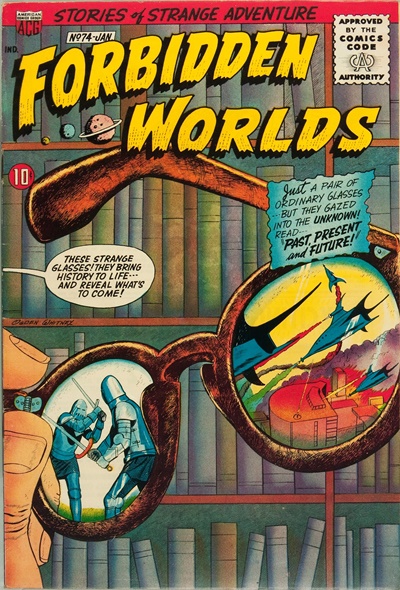 American Comics Group did this very odd little story in the back of Forbidden Worlds #74 (November 1958). It was about a fat
little boy named Herbie Poppenecker. His father would angrily complain about him to his wife, calling him a little fat nothing.
But what his father didn't know was that Herbie was a very uncharacteristic hero. Presidents would call on him to solve their
problems. He would travel through time, seduce women, foil alien invasions and more. He did all this with the use of his magic
lollipops which he usually had an ample supply of. The character proved popular enough to warrant several repeat appearances
in Forbidden Worlds and eventually his own title (February 1964).
His own title would end in early 1967 not because of slow sales because of illness of the editor Leo Rosenbaum (who wrote
under many pen names - often Richard E. Hughes). ACG would go out of business later that year. The strip was illustrated by
Ogden Whitney whose stiff, subtle style was a perfect match for the character. Both Leo and Ogden would die a few years after
ACGs shutdown. Herbie is fondly remembered by people in comics and a few artists have tried doing new stories with the
character but without much success.
American Comics Group did this very odd little story in the back of Forbidden Worlds #74 (November 1958). It was about a fat
little boy named Herbie Poppenecker. His father would angrily complain about him to his wife, calling him a little fat nothing.
But what his father didn't know was that Herbie was a very uncharacteristic hero. Presidents would call on him to solve their
problems. He would travel through time, seduce women, foil alien invasions and more. He did all this with the use of his magic
lollipops which he usually had an ample supply of. The character proved popular enough to warrant several repeat appearances
in Forbidden Worlds and eventually his own title (February 1964).
His own title would end in early 1967 not because of slow sales because of illness of the editor Leo Rosenbaum (who wrote
under many pen names - often Richard E. Hughes). ACG would go out of business later that year. The strip was illustrated by
Ogden Whitney whose stiff, subtle style was a perfect match for the character. Both Leo and Ogden would die a few years after
ACGs shutdown. Herbie is fondly remembered by people in comics and a few artists have tried doing new stories with the
character but without much success.
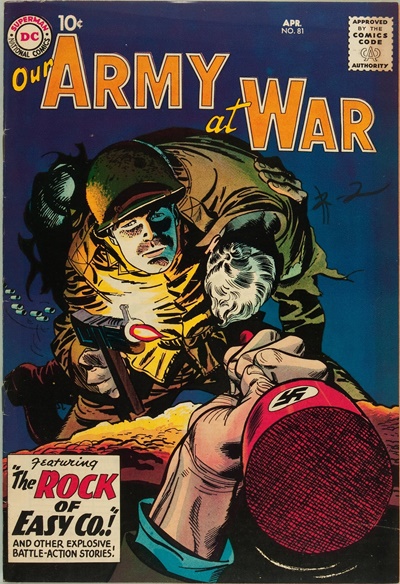 DC Comics had a number of successful ongoing war comics and over time regular characters would take them over. The most
popular character to come from these war titles would be Sgt. Rock, who first appeared in Our Army at War #81 (February 1959).
The characters first appearance would be written by Bob Haney and drawn by Ross Andru. The character was created by Robert
Kanigher and Joe Kubert who soon took over the character. It should be said that Sgt. Rock had a prototype appearance in
G.I. Combat #86 (1958), but he is called "The Rock". With this issue he is called "Rocky" but The Easy Company, the crew that
Sgt. Rock operated with make their first appearance here. Sgt. Rock would become the main feature of Our Army at War and would
have the title renamed to Sgt. Rock with issue #302. From there the continued until #422 and end in 1988.
DC Comics had a number of successful ongoing war comics and over time regular characters would take them over. The most
popular character to come from these war titles would be Sgt. Rock, who first appeared in Our Army at War #81 (February 1959).
The characters first appearance would be written by Bob Haney and drawn by Ross Andru. The character was created by Robert
Kanigher and Joe Kubert who soon took over the character. It should be said that Sgt. Rock had a prototype appearance in
G.I. Combat #86 (1958), but he is called "The Rock". With this issue he is called "Rocky" but The Easy Company, the crew that
Sgt. Rock operated with make their first appearance here. Sgt. Rock would become the main feature of Our Army at War and would
have the title renamed to Sgt. Rock with issue #302. From there the continued until #422 and end in 1988.
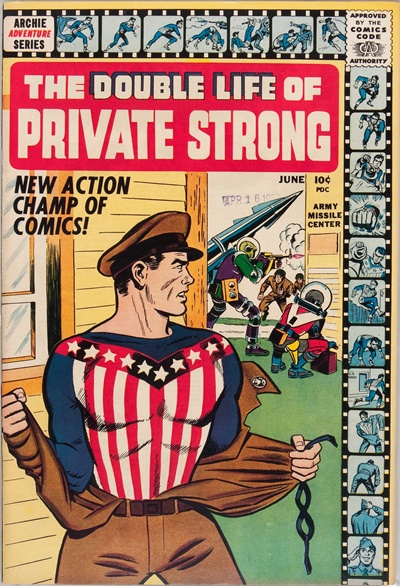 DC were not the only publishers doing superheroes. Archie Comics brought some of their old superheroes back and created new
ones too. The hired the team of Joe Simon and Jack Kirby to do the line. In June of 1959 out came The Double Life of Private
Strong, an updated version of The Shield. The book only went two issues though. Within it was another superhero called The Fly.
Archie would have better results with The Adventures of the Fly (May 1959)
as it would go 30 issues, ending in 1964. After 6 months it came back under the title Fly Man and continued its original
numbering going from 31 to 39 and ending in July of 1966. From there the title would be renamed Mighty Comics and go from
issue 40 to issue 50 (October 1966 - August 1967). A storyline from Fly Man would move into The Mighty Crusaders
(September 1965), a 7 issue series featuring a group of superheroes, including The Shield, The Fly, Fly Girl, The Comet and
The Black Hood. With issue 4 a large number of 1940s Archie Superheroes would be brought back. This comic was scripted by
Jerry Siegel co-creator of Superman and drawn by Paul Reinman. The Archie Superheroes have been brought back multiple times
since then but they never manage to stay very long. Even DC tried under an !mpact line without much success.
DC were not the only publishers doing superheroes. Archie Comics brought some of their old superheroes back and created new
ones too. The hired the team of Joe Simon and Jack Kirby to do the line. In June of 1959 out came The Double Life of Private
Strong, an updated version of The Shield. The book only went two issues though. Within it was another superhero called The Fly.
Archie would have better results with The Adventures of the Fly (May 1959)
as it would go 30 issues, ending in 1964. After 6 months it came back under the title Fly Man and continued its original
numbering going from 31 to 39 and ending in July of 1966. From there the title would be renamed Mighty Comics and go from
issue 40 to issue 50 (October 1966 - August 1967). A storyline from Fly Man would move into The Mighty Crusaders
(September 1965), a 7 issue series featuring a group of superheroes, including The Shield, The Fly, Fly Girl, The Comet and
The Black Hood. With issue 4 a large number of 1940s Archie Superheroes would be brought back. This comic was scripted by
Jerry Siegel co-creator of Superman and drawn by Paul Reinman. The Archie Superheroes have been brought back multiple times
since then but they never manage to stay very long. Even DC tried under an !mpact line without much success.
Behind the Scenes - Breaking In, sorta.
Neal Adams was teenager looking for work in the comics industry in 1959. Among the people he went to was Joe Simon who was
editing (and more) the superhero books from Archie. Neal left his portfolio there for them to look at overnight. When he came
back he was told there wasn't any work for him, but they did find a neat panel of Tommy Troy turning into the Fly and they
used it in Adventures of the Fly #4. Although uncredited, it is Neal Adams first work in comic books. Neal would become a very
popular artist in the late 60s and the 70s. He would also fight successfully to improve creator rights.
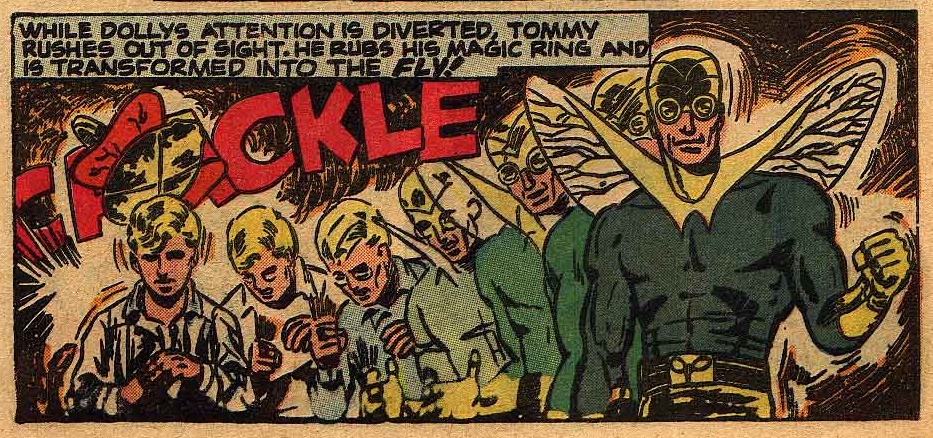
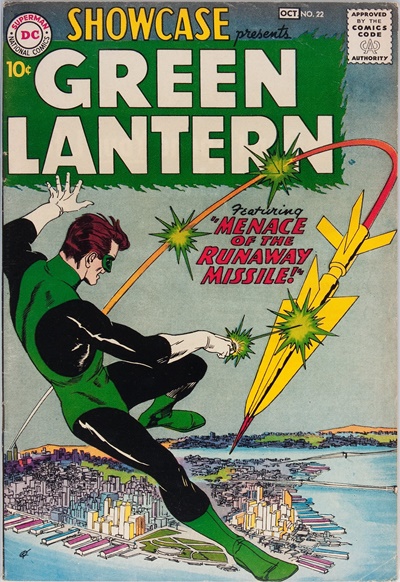 Also appearing in Showcase Comics was a new revival of the Green Lantern. Like the Flash, he was changed to appeal the new
kids now reading comics. The character first appeared in issue #22 (July 1959), the revamped character creators were writer
John Broome and artist Gil Kane. DC Editor Julie Schwartz already knew he had a hit on his hand and gave the character a
dedicated series before seeing the sales of the Showcase stories. Green Lantern's solo series went 205 issues from July 1960
to October 1986. The end was due to an almost line wide restarting of DC comics superhero titles and Green Lantern has pretty
much been in print since his debut. What has helped the Green Lantern is the flexibility of the concept. It's about an Earth
man selected to be a space police officer. His jurisdiction is a sector of space that includes the Earth, but also many other
planets. He has an energy ring that gives him the ability to create anything he can imagines. The ring needs to be charged
every 24 hours by holding it up to the Green Lantern battery and saying an oath. Over the years the Green Lantern has changed
from person to person, sometimes for years even, but would eventually go back to Hal Jordan. Gil Kane's design of the
character was very appealing as he gave the character a sleek, smooth style and he had the flying character in a costume that
didn't include a cape.
Also appearing in Showcase Comics was a new revival of the Green Lantern. Like the Flash, he was changed to appeal the new
kids now reading comics. The character first appeared in issue #22 (July 1959), the revamped character creators were writer
John Broome and artist Gil Kane. DC Editor Julie Schwartz already knew he had a hit on his hand and gave the character a
dedicated series before seeing the sales of the Showcase stories. Green Lantern's solo series went 205 issues from July 1960
to October 1986. The end was due to an almost line wide restarting of DC comics superhero titles and Green Lantern has pretty
much been in print since his debut. What has helped the Green Lantern is the flexibility of the concept. It's about an Earth
man selected to be a space police officer. His jurisdiction is a sector of space that includes the Earth, but also many other
planets. He has an energy ring that gives him the ability to create anything he can imagines. The ring needs to be charged
every 24 hours by holding it up to the Green Lantern battery and saying an oath. Over the years the Green Lantern has changed
from person to person, sometimes for years even, but would eventually go back to Hal Jordan. Gil Kane's design of the
character was very appealing as he gave the character a sleek, smooth style and he had the flying character in a costume that
didn't include a cape.
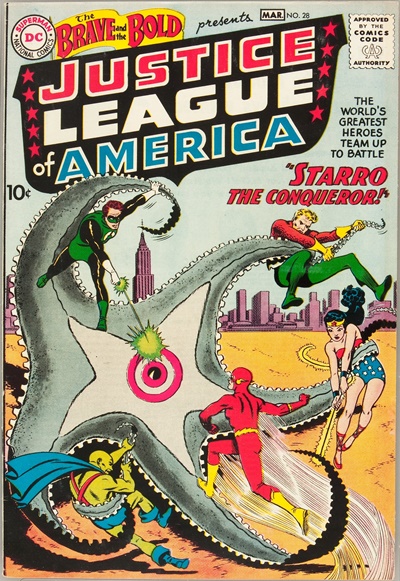 In Brave and the Bold #28 December (1959) The Justice League of America was created. This was a super group of all of DC
titles most popular Superheroes. It's line up consisted of Superman, Batman, Wonder Woman, Flash, Green Lantern, Aquaman and
Martian Manhunter. They would soon get their own comic starting in August 1960. The artist for this series was Mike Sekowsky,
the writer Gardner Fox. These two did an exceptional job of taking a normal 20-24 page comic story and telling a one issue
stories that featured all the characters. This is something many writers and artists still have trouble doing today. The
Justice League of America has been one of DC's most enduring titles. It has been in publication since it started, although
it has gone through some renaming and renumbering along the way. It has also had many changes to its membership as new
characters join the team and others leave.
In Brave and the Bold #28 December (1959) The Justice League of America was created. This was a super group of all of DC
titles most popular Superheroes. It's line up consisted of Superman, Batman, Wonder Woman, Flash, Green Lantern, Aquaman and
Martian Manhunter. They would soon get their own comic starting in August 1960. The artist for this series was Mike Sekowsky,
the writer Gardner Fox. These two did an exceptional job of taking a normal 20-24 page comic story and telling a one issue
stories that featured all the characters. This is something many writers and artists still have trouble doing today. The
Justice League of America has been one of DC's most enduring titles. It has been in publication since it started, although
it has gone through some renaming and renumbering along the way. It has also had many changes to its membership as new
characters join the team and others leave.
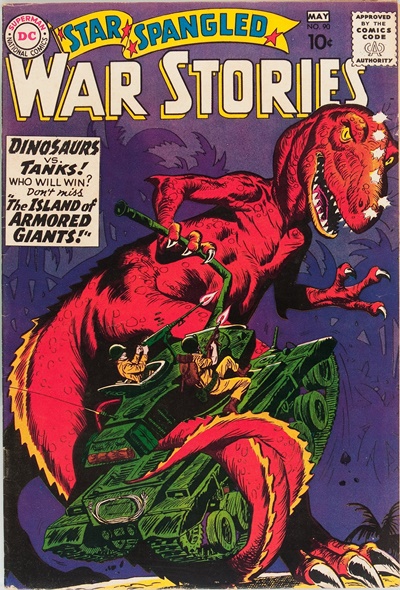 Star Spangled War Stories #90 (April 1960) had a strange story involving The Army (with tanks) fighting Dinosaurs. It must have been
popular as the theme of Army vs. Dinosaurs was used quite a bit afterwards. It appeared again in issue #92, then from #94 all
the way to issue #137 (February 1968) there were Dinosaurs vs military stories. The one exception was issue #126, that had an
Army Ape cover. The feature would eventually be named War That Time Forgot. The story from #90 was written by Robert Kanigher
and the art was by Ross Andru & Mike Esposito. Kanigher wrote the bulk of the stories but got other artists like Joe Kubert
and Russ Heath to draw it after a while. The series of stories takes place during WWII where a group of Marines go to an
island that they discover is filled with Dinosaurs, they then go from one Dinosaur to another attacking them and usually at
least one person makes it off the island alive.
Star Spangled War Stories #90 (April 1960) had a strange story involving The Army (with tanks) fighting Dinosaurs. It must have been
popular as the theme of Army vs. Dinosaurs was used quite a bit afterwards. It appeared again in issue #92, then from #94 all
the way to issue #137 (February 1968) there were Dinosaurs vs military stories. The one exception was issue #126, that had an
Army Ape cover. The feature would eventually be named War That Time Forgot. The story from #90 was written by Robert Kanigher
and the art was by Ross Andru & Mike Esposito. Kanigher wrote the bulk of the stories but got other artists like Joe Kubert
and Russ Heath to draw it after a while. The series of stories takes place during WWII where a group of Marines go to an
island that they discover is filled with Dinosaurs, they then go from one Dinosaur to another attacking them and usually at
least one person makes it off the island alive.
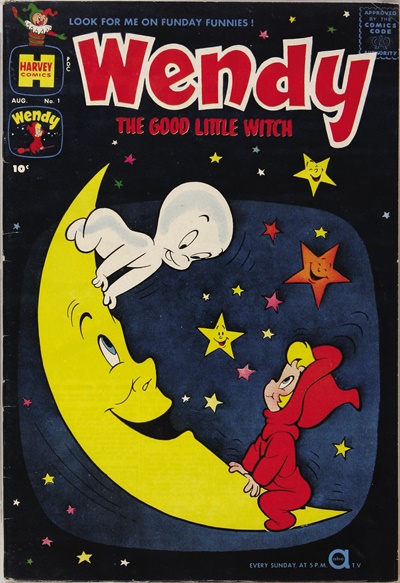 Harvey Comics would have another hit starting in May 1960. They would publish Wendy the Good Little Witch #1 in August of 1960,
the comic did a very respectable 97 issue run. Her series was published sporadically towards the end. Issue 93 was published
in 1976, then #94 to 97 in 1990. The title was restarted with a new #1 in 1991 and went 15 issues, ending in 1994. She also
had a spin off series Wendy Witch World that went 53 issues (1961 - 1974) and a team up comic with Casper called Casper and
Wendy (8 issues, 1972-1973). Wendy, the Good Little Witch was created by Steve Mufatti. Like Casper she was a child that was
good when the adults raising them want them to be bad, like them. Wendy made her first appearance in
Casper the Friendly Ghost #20
(March 1954). She would 7 stories and cover appearances in Harvey's Hits between 1958 and 1960 (issues 7, 16, 21, 23, 27, 30, 33)
and was then given her own solo book.
Harvey Comics would have another hit starting in May 1960. They would publish Wendy the Good Little Witch #1 in August of 1960,
the comic did a very respectable 97 issue run. Her series was published sporadically towards the end. Issue 93 was published
in 1976, then #94 to 97 in 1990. The title was restarted with a new #1 in 1991 and went 15 issues, ending in 1994. She also
had a spin off series Wendy Witch World that went 53 issues (1961 - 1974) and a team up comic with Casper called Casper and
Wendy (8 issues, 1972-1973). Wendy, the Good Little Witch was created by Steve Mufatti. Like Casper she was a child that was
good when the adults raising them want them to be bad, like them. Wendy made her first appearance in
Casper the Friendly Ghost #20
(March 1954). She would 7 stories and cover appearances in Harvey's Hits between 1958 and 1960 (issues 7, 16, 21, 23, 27, 30, 33)
and was then given her own solo book.
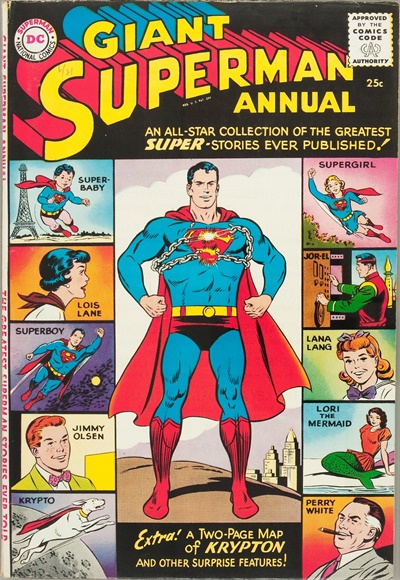 In June of 1960 DC Comics published a thick 25 cent comic called Giant Superman Annual. In it was reprints, a map of Krypton
and old covers. The book did well enough that DC would do others focused on their other big characters. Marvel would do them
too. Annuals would eventually contain original stories, sometimes tied into a major story going on in the regular title.
During the mid-1980s and 1990s they would have a story running through a variety of annuals to get readers to buy them all,
instead of just their favorite characters. 40 years later, the annual doesn't have the importance it once did and publishers
tend to go back and forth on publishing them.
In June of 1960 DC Comics published a thick 25 cent comic called Giant Superman Annual. In it was reprints, a map of Krypton
and old covers. The book did well enough that DC would do others focused on their other big characters. Marvel would do them
too. Annuals would eventually contain original stories, sometimes tied into a major story going on in the regular title.
During the mid-1980s and 1990s they would have a story running through a variety of annuals to get readers to buy them all,
instead of just their favorite characters. 40 years later, the annual doesn't have the importance it once did and publishers
tend to go back and forth on publishing them.
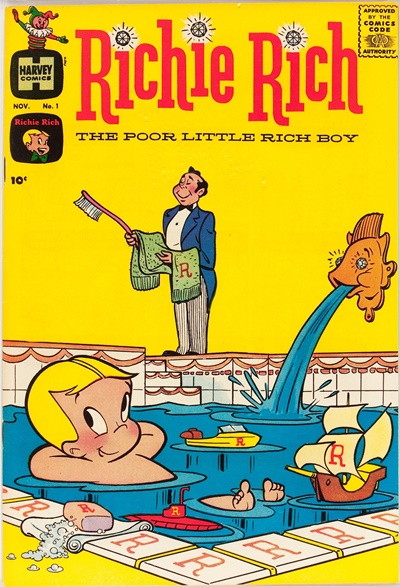 The big success for Harvey began in August 1960. It was Richie Riches own title, starting in November of 1960. It would be the
first of many Richie Rich titles. Richie Rich went 254 issues ending in 1990. Like some other Harvey characters, the title went
on a long hiatus in the 80s. In Richie's case it stopped in 1982 (#218) and restarted in 1986 (#219). The Richie Rich comic was
immediately restarted with a new #1 in December of 1990 and went 28 issues ending in 1994. Richie Rich was an insanely wealthy
boy who often out smarted thieves who was trying to steal his and his father's wealth.
The big success for Harvey began in August 1960. It was Richie Riches own title, starting in November of 1960. It would be the
first of many Richie Rich titles. Richie Rich went 254 issues ending in 1990. Like some other Harvey characters, the title went
on a long hiatus in the 80s. In Richie's case it stopped in 1982 (#218) and restarted in 1986 (#219). The Richie Rich comic was
immediately restarted with a new #1 in December of 1990 and went 28 issues ending in 1994. Richie Rich was an insanely wealthy
boy who often out smarted thieves who was trying to steal his and his father's wealth.
The Richie Rich titles were:
| Richie Rich Bank Book - 59 issues in 1972 - 1982 |
Richie Rich Diamonds - 59 issues in 1972 - 1982 |
| Richie Rich Jackpots - 58 issues in 1972 - 1982 |
Richie Rich Money World - 59 issues in 1972 - 1982 |
| Richie Rich Riches - 59 issues in 1972 - 1982 |
Richie Rich & Jackie Jokers - 48 issues in 1973 - 1982 |
| Richie Rich & Casper - 45 issues in 1974 - 1982 |
Richie Rich & Dot - 1 issue in 1974 |
| Richie Rich Billions - 48 issues in 1974 - 1982 |
Richie Rich Cash - 47 issues in 1974 - 1982 |
| Richie Rich Gems - 43 issues in 1974 - 1982 |
Richie Rich Profits - 47 issues in 1974 - 1982 |
| Richie Rich Vault of Mystery - 5 issues in 1974 - 1975 |
Richie Rich Gold and Silver - 42 issues in 1975 - 1982 |
| Richie Rich Vaults of Mystery - 42 issues in 1975 - 1982 |
Richie Rich Zillionz - 33 issues in 1976 - 1982 |
| Richie Rich, Casper and Wendy -- National League - 1 issue in 1976 |
Richie Rich & Billy Bellhops - 1 issue in 1977 |
| Richie Rich & Cadbury - 29 issues in 1977 - 1991 |
Richie Rich & Dollar the Dog - 24 issues in 1977 - 1982 |
| Richie Rich & Gloria - 25 issues in 1977 - 1982 |
Richie Rich and Timmy Time - 1 issue in 1977 |
| Richie Rich Best of the Years - 6 issues in 1977 - 1980 |
Richie Rich Digest Stories - 17 issues in 1977 - 1982 |
| Richie Rich Digest Winners - 16 issues in 1977 - 1982 |
Richie Rich Inventions - 26 issues in 1977 - 1982 |
| Richie Rich Vacations Digest - 9 issues in 1977 - 1982 |
Richie Rich & His Girlfriends - 16 issues in 1979 - 1982 |
| Richie Rich and His Mean Cousin Reggie - 3 issues in 1979 - 1989 |
Richie Rich Holiday Digest Magazine - 5 issues in 1980 - 1989 |
| Richie Rich Million Dollar Digest - 10 issues in 1980 - 1982 |
Richie Rich Treasure Chest Digest - 3 issues in 1982 - 1982 |
| Richie Rich Digest Magazine - 42 issues in 1986 - 1994 |
Richie Rich and [...] - 11 issues in 1987 - 1990 |
| Richie Rich Relics - 4 issues in 1988 - 1989 |
Richie Rich and Professor Keenbean - 2 issues in 1990 - 1990 |
| Richie Rich Gold Nuggets Digest - 4 issues in 1990 - 1991 |
Richie Rich - 28 issues in 1991 - 1994 |
| Richie Rich and The New Kids on the Block - 3 issues in 1991 - 1991 |
Richie Rich Big Bucks - 8 issues in 1991 - 1992 |
| Richie Rich Million Dollar Digest - 12 issues in 1991 - 1994 |
Richie Rich Money World Digest - 8 issues in 1991 - 1993 |
| Richie Rich Summer Bonanza - 1 issue in 1991 |
Richie Rich Vacation Digest Magazine - 1 issue in 1991 |
| Richie Rich Adventure Digest Magazine - 7 issues in 1992 - 1994 |
Richie Rich Big Book - 2 issues in 1992 - 1993 |
| Richie Rich Cash Money - 2 issues in 1992 - 1992 |
Richie Rich Giant Size - 4 issues in 1992 - 1993 |
| Richie Rich Vacation Digest - 1 issue in 1992 |
Richie Rich Vacation Digest '93 Magazine - 1 issue in 1993 |
In 1980 Richie Rich had a peak of being in 26 regular comic books and digest sized series being published concurrently. No
comic book character has ever before or since had that many ongoing titles. Richie Rich was also the on the cover of all 12
of the 16 issues of Harvey Collectors Classic which ran from 1975 to 1979. Those issues reprinted a variety of Richie Rich
stories. There are well over 1000 comics printed with Richie Rich in it. Both the publisher Alfred Harvey and Warren Kremer
have claimed to have created Richie Rich. His first appearance in Little Dot #1 was drawn by Steve Muffati with Larz Bourne
doing the script.
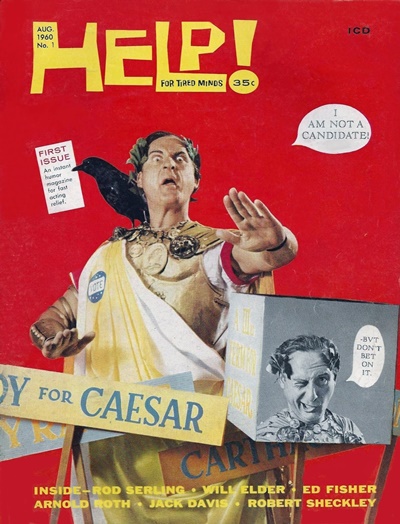 Harvey Kurtzman tried again to put out a magazine to compete with MAD. Help! was in circulation from 1960 to 1965. The magazine
was a mix of comic stories and fumetti (Italian word for comics done with photographs - means literally "Puffs of Smoke" to
describe the word/thought balloons). This comic had a lot of talent on it that would make major waves in a variety of media
around the world. Among them would be writer/assistant editor Gloria Steinem who would become famous for her views on women's
issues. Terry Gilliam of Monty Pythons Flying Circus also worked on this magazine, John Cleese (also of Monty Python fame)
would appear in photo's. This magazine also published the first work of Robert Crumb, Gilbert Shelton, Jay Lynch, and Skip
Wilson all of whom would become heavyweights in the Underground market (which you will read about later). The magazine was
financed by Warren Publishing, who would start far more successful magazines in the near future. Help! was also an education
in humor as it would reprint comedy work from Winsor McCay, Bud Fisher, Milt Gross, Milton Caniff, T.S. Sullivant, H. M.
Bateman, and Will Eisner. What hurt this magazine was its erratic publishing schedule as it went from monthly, to bi-monthly
to quarterly and back again. Nonetheless, due to Harvey's satirical humor in Mad Magazine and this particular magazine, he is
considered to be the grandfather of Underground Comics.
Harvey Kurtzman tried again to put out a magazine to compete with MAD. Help! was in circulation from 1960 to 1965. The magazine
was a mix of comic stories and fumetti (Italian word for comics done with photographs - means literally "Puffs of Smoke" to
describe the word/thought balloons). This comic had a lot of talent on it that would make major waves in a variety of media
around the world. Among them would be writer/assistant editor Gloria Steinem who would become famous for her views on women's
issues. Terry Gilliam of Monty Pythons Flying Circus also worked on this magazine, John Cleese (also of Monty Python fame)
would appear in photo's. This magazine also published the first work of Robert Crumb, Gilbert Shelton, Jay Lynch, and Skip
Wilson all of whom would become heavyweights in the Underground market (which you will read about later). The magazine was
financed by Warren Publishing, who would start far more successful magazines in the near future. Help! was also an education
in humor as it would reprint comedy work from Winsor McCay, Bud Fisher, Milt Gross, Milton Caniff, T.S. Sullivant, H. M.
Bateman, and Will Eisner. What hurt this magazine was its erratic publishing schedule as it went from monthly, to bi-monthly
to quarterly and back again. Nonetheless, due to Harvey's satirical humor in Mad Magazine and this particular magazine, he is
considered to be the grandfather of Underground Comics.
Help! Would be one of many significant magazines that Warren Publishing would produce. Jim Warren was born in 1930 and grew
up loving comic strips, particularly adventure comic strips like Prince Valiant and Dick Tracy, he learned how to draw when he
was young and was going to school to become an architect. Then the US got involved in the Korean police action and Jim dropped
out of school and enlisted. During a training exercise, .50 caliber bullets whizzed by his head and did some irreparable nerve
damage to his ears harming his ability to hear and giving him tinnitus. After he was discharged he started up a one-man
advertising agency and that lead into an assistant advertising manager job for the Caloric Appliance Corporation. While there
he was reading the new Playboy magazine and fell in love with what Hugh Hefner created. He left his job and published a
Playboy knock off magazine called After Hours, it only went 4 issues. In Philadelphia, a District Attorney was running for
re-election and decided to run a public crusade against pornography. Because Jim was based in Philadelphia he was arrested on
charges of obscenity. He had used a photo of a topless Betty Page as his centerfold. Jim was photographed and labeled a
pornographer by the government and media and it badly tarnished his reputation. When the case was brought to court, the judge
quickly dismissed the charges but that didn't make front page news. Not that it really mattered, by then the election was over
and the D. A. had won his re-election. The one good thing to come from After Hours was Jim meeting Forrest J. Ackerman who was
an agent looking for magazines to publish stories by his clients. That lead to Warren publishing a Famous Monsters of Filmland
magazine which included some comics and that lead to him publishing comic magazines.
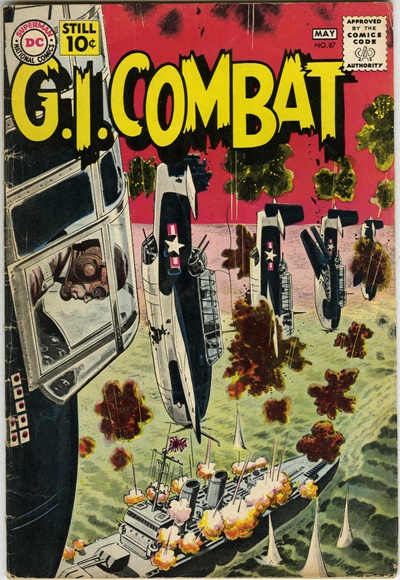 Haunted Tank first appearance was in GI Combat #87 (February, 1961). The Haunted Tank is about Jeb Stuart, who commands a Tank
in WWII. Alexander the Great commands Jeb's Confederate General ancestor J.E.B. Stuart ghost to watch over him and his tank.
Only the young Stuart can see and talk to him, so his crew thinks he's crazy but the advice he gets from his family ghost wins
them battles. Over time members of Stuart's crew are killed and replaced, as is the Tank itself. Haunted Tank was created by
Robert Kanigher and Russ Heath. Haunted Tank became the main feature of GI Combat and stopped appearing regularly when the comic
ended with issue 288 (December 1986). The feature has since made appearances in other titles, specials and miniseries.
Haunted Tank first appearance was in GI Combat #87 (February, 1961). The Haunted Tank is about Jeb Stuart, who commands a Tank
in WWII. Alexander the Great commands Jeb's Confederate General ancestor J.E.B. Stuart ghost to watch over him and his tank.
Only the young Stuart can see and talk to him, so his crew thinks he's crazy but the advice he gets from his family ghost wins
them battles. Over time members of Stuart's crew are killed and replaced, as is the Tank itself. Haunted Tank was created by
Robert Kanigher and Russ Heath. Haunted Tank became the main feature of GI Combat and stopped appearing regularly when the comic
ended with issue 288 (December 1986). The feature has since made appearances in other titles, specials and miniseries.
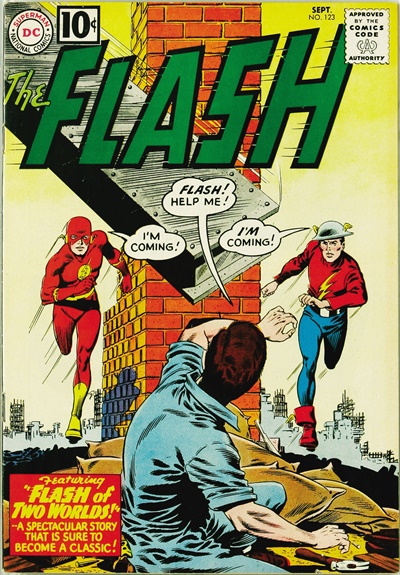 The "Golden Age" and "Silver Age" of superhero comic collided in Flash #123 (July 1961). In this story called "The Flash of Two
Worlds", they showed the current Flash reading superhero comic books as a kid - comic books that were published in the 1940s.
Later on in that story, that Flash would meet the 1940s Flash. They explained the meeting by saying the Golden Age Superheroes
were real in a parallel world called Earth 2, while the current Flash was in Earth 1. The Flash's power allowed him to travel
between these worlds. The use of separate worlds would open a Pandora's Box as a wide variety of characters both new and bought
from other publishers would all end up getting their own "Earths" and would cross over to meet the current heroes. Fans both
young and old enjoyed this but 30 years later the editors did not.
The "Golden Age" and "Silver Age" of superhero comic collided in Flash #123 (July 1961). In this story called "The Flash of Two
Worlds", they showed the current Flash reading superhero comic books as a kid - comic books that were published in the 1940s.
Later on in that story, that Flash would meet the 1940s Flash. They explained the meeting by saying the Golden Age Superheroes
were real in a parallel world called Earth 2, while the current Flash was in Earth 1. The Flash's power allowed him to travel
between these worlds. The use of separate worlds would open a Pandora's Box as a wide variety of characters both new and bought
from other publishers would all end up getting their own "Earths" and would cross over to meet the current heroes. Fans both
young and old enjoyed this but 30 years later the editors did not.
 In August of 1955, DC published Brave and the Bold #1. The debuting issue had three sword fighting heroes. The 3 reoccurring
features were The Golden Gladiator written by France Herron with artist Russ Heath, Viking Prince by editor/writer Robert
Kanigher and artist by Joe Kubert and The Silent Knight also by Robert Kanigher with artist Irv Novick. The majority of the
early covers feature Silent Knight but Viking Prince and a newer feature Robin Hood would also appear. With
issue #25 The Suicide Squad would debut.
It was about a team of military personal who were each the sole survivors of an event. They used their knowledge and
skills to take on threats out of science fiction that the regular military couldn't handle. It was also done by Robert
Kanigher but with artists Ross Andru & Mike Esposito. While the group would later on reappear in the title the name Suicide
Squad would be given to a superhero group - or rather, Supervillains now doing dangerous, dirty government work in order to
get a pardon. Brave and the Bold would debut some more characters and teams, then would become a team up book for two popular
superheroes and or groups, which we'll get to. With issue #74 on, it turned into a Batman and another hero team up book. Over
all this title would go until 1983 ending with issue #200. The last story featured Batman and the Outsiders, which started
their own title the very next month.
In August of 1955, DC published Brave and the Bold #1. The debuting issue had three sword fighting heroes. The 3 reoccurring
features were The Golden Gladiator written by France Herron with artist Russ Heath, Viking Prince by editor/writer Robert
Kanigher and artist by Joe Kubert and The Silent Knight also by Robert Kanigher with artist Irv Novick. The majority of the
early covers feature Silent Knight but Viking Prince and a newer feature Robin Hood would also appear. With
issue #25 The Suicide Squad would debut.
It was about a team of military personal who were each the sole survivors of an event. They used their knowledge and
skills to take on threats out of science fiction that the regular military couldn't handle. It was also done by Robert
Kanigher but with artists Ross Andru & Mike Esposito. While the group would later on reappear in the title the name Suicide
Squad would be given to a superhero group - or rather, Supervillains now doing dangerous, dirty government work in order to
get a pardon. Brave and the Bold would debut some more characters and teams, then would become a team up book for two popular
superheroes and or groups, which we'll get to. With issue #74 on, it turned into a Batman and another hero team up book. Over
all this title would go until 1983 ending with issue #200. The last story featured Batman and the Outsiders, which started
their own title the very next month.



























